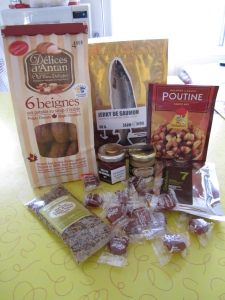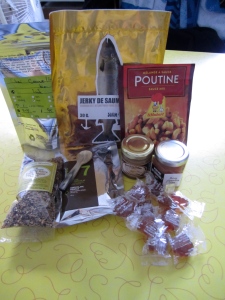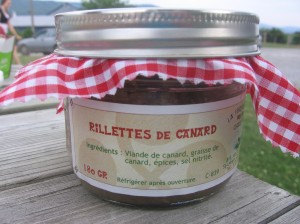(and X is for waXing philosophical)
The hordes are back at school, the suits are out in full force downtown, and the air is crisp – summer, alas, is waning.
Autumn is my favourite season. Can you smell it? It smells like a fresh start, a clear head, a sweater, a pile of leaves, a freshly-stoked fireplace. It tastes like turkey, fresh cranberries, gourds of various shapes and sizes, and apples.
Always, apples.
One of the (many) strange (and in this case, lovely) things about being the child of an Anglican minister (well, of two Anglican ministers, but let’s just let that go for now, ok? Ok…) is that you get to discover new communities every time your parental unit is moved to a new parish. Thus we moved from the wilds of Laval (it was the wilds back then, sort of) to walks along the riverfront in Verdun, to fireworks in St Lambert, to the rolling hills of the Montérégie.
We lived in Otterburn Park, nestled at the foot of Mont St. Hilaire (a mountain I climbed several times during our three years there). Were you to jump in a car and drive along Chemin de la Montagne, hugging Mont St. Hilaire’s south peak (as we did every Sunday), you would reach Rougemont, one of three points in my mother’s parish, and the heart of Quebec’s apple industry.
 No place ever spoke to me like Rougemont did. Granted, the small town had all the right Alex ingredients: a deserted, romantic graveyard, a picturesque, tiny church, a host of eccentric characters, and (let’s be honest here) horses. It also, of course, had orchards: orchards as far as the eye could see, leading up in pin-straight rows or haphazard zigzags to the Rougemont mountain itself. I learned a great deal about farming in those years: I saw early mornings and late nights, biting frost and blighting sun. I, less so than my mother but still enough to make an impression, was invited into the old farmhouses of Anglophone rural Quebec: butter churners and rocking chairs, wooden stools and hiking boots. I ate fresh corn on the cob, I bore witness to the most magnificent Thanksgiving altar displays; singing the hymn “Come Ye Thankful People Come” never had such humble significance. I also got my first shock from an electric fence, but never mind that now.
No place ever spoke to me like Rougemont did. Granted, the small town had all the right Alex ingredients: a deserted, romantic graveyard, a picturesque, tiny church, a host of eccentric characters, and (let’s be honest here) horses. It also, of course, had orchards: orchards as far as the eye could see, leading up in pin-straight rows or haphazard zigzags to the Rougemont mountain itself. I learned a great deal about farming in those years: I saw early mornings and late nights, biting frost and blighting sun. I, less so than my mother but still enough to make an impression, was invited into the old farmhouses of Anglophone rural Quebec: butter churners and rocking chairs, wooden stools and hiking boots. I ate fresh corn on the cob, I bore witness to the most magnificent Thanksgiving altar displays; singing the hymn “Come Ye Thankful People Come” never had such humble significance. I also got my first shock from an electric fence, but never mind that now.
I picked apples: up ladders and down. I ate apples: fresh apples, cooked apples, apple crisp, apple pie. I grew to love and respect the trees and their fruit; I could identify dozens of types of apples by smell and taste.
 I am lucky enough to still have a Rougemont farmer in my life; one of the lesser blessings is the bags of apples he brings me every autumn. I’ve moved from Otterburn, to Bedford, then Pointe Claire, and Montreal (2 apartments; 1 condo), and now Ottawa; the bags follow. There are few more happy phrases uttered than, “Alexandra, I’ve got some Cortlands for you!” Cortlands remain my favourites: their tart, crisp, clear white insides, and the way their red skins bleed a little when you cut them, are a constant marvel (wait, that sounds weird, doesn’t it? Have I been watching too many criminal dramas?). My mother favours Paula Reds; my husband likes Spy apples (which I turn my nose up as an Ontario apple). I hate nothing more than the wax they put on apples to give them a shine in the grocery store: those things look to me like the fruit equivalent of someone with a fake tan: why take a good thing to extremes? I am also a local cider fiend: the best, in my book, is Covey Hill’s own Mystique. An excellent article about the cider route in Quebec is here, featuring Rougemont’s most well-known cider-making resident, Michel Jodoin.
I am lucky enough to still have a Rougemont farmer in my life; one of the lesser blessings is the bags of apples he brings me every autumn. I’ve moved from Otterburn, to Bedford, then Pointe Claire, and Montreal (2 apartments; 1 condo), and now Ottawa; the bags follow. There are few more happy phrases uttered than, “Alexandra, I’ve got some Cortlands for you!” Cortlands remain my favourites: their tart, crisp, clear white insides, and the way their red skins bleed a little when you cut them, are a constant marvel (wait, that sounds weird, doesn’t it? Have I been watching too many criminal dramas?). My mother favours Paula Reds; my husband likes Spy apples (which I turn my nose up as an Ontario apple). I hate nothing more than the wax they put on apples to give them a shine in the grocery store: those things look to me like the fruit equivalent of someone with a fake tan: why take a good thing to extremes? I am also a local cider fiend: the best, in my book, is Covey Hill’s own Mystique. An excellent article about the cider route in Quebec is here, featuring Rougemont’s most well-known cider-making resident, Michel Jodoin.
In a life somewhat geographically schizophrenic, nothing takes me back to lazy teenage days in the country quite like a fresh bag of apples, tied tight and stowed in the car, promises to future autumn afternoons.
Some apple factoids to crunch on:
- Apple saplings came over to the New World with Champlain
- That cad, Sir George Simpson, turned up on the shores of the most westerly HBC fort with apple seeds tucked into his vest pocket
- McIntosh apples are as Canadian as, well, I’ll let you fill that blank in…: Every McIntosh can trace itself back to one discovered in 1811 by John McIntosh in Dundas County, Ontario.
- Did you know that Canadian researchers analysed eight popular types of apples and found Red Delicious, Northern Spy and Ida Red had the most antioxidants? Guess I should play nice, then.
- Apples should be stored in a cool, dark, slightly moist place: I put mine in the crisper drawer of the fridge, with a dark, wet tea towel completely covering them (yes, I chortle when I tuck them back in).
My favourite apple crisp recipe (adapted from Nigella Lawson’s How to Be A Domestic Goddess Baking and the Art of Comfort Cooking and The Yoga Cookbook: Vegetarian Food for Body and Mind, by the Sivananda Yoga Vedanta Centres):
 Filling ingredients:
Filling ingredients:
- 4 large apples, sliced into eighths, skin on
- 25 g raisins
- 1 teaspoon ground cinnamon
- 1 teaspoon lemon juice
- 1/2 teaspoon grated fresh ginger
 Topping ingredients:
Topping ingredients:
- 60 g chopped walnuts
- 2 1/2 cups granola (I swear by this stuff)
- 1 1/4 cups flour
- 1/2 cup butter
- 1 2/3 cups honey and/or maple syrup (I like to mix both)
Preheat the oven to 350°F (180°C). Mix the filling ingredients together and transfer into an 8-inch square baking dish. Combine flour with butter, then honey and/or syrup and mix well. Stir the liquid mixture into the granola. Spoon the topping over the filling. Bake for 45 minutes.
Tags: apples, bakery, comfort food, dessert, farming, fruit, Quebec, recipes, rougemont


















